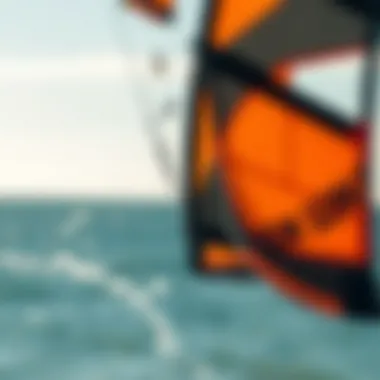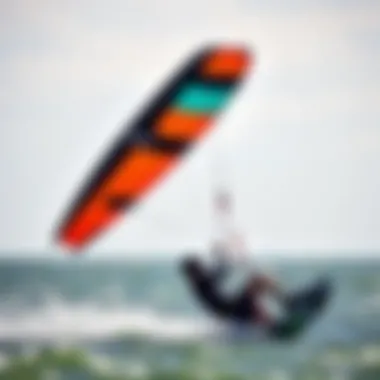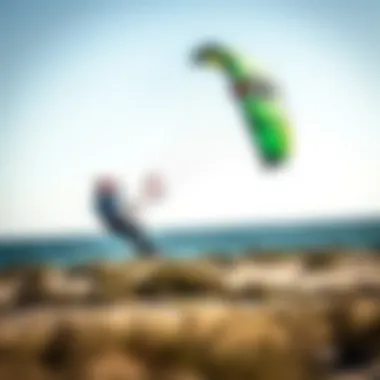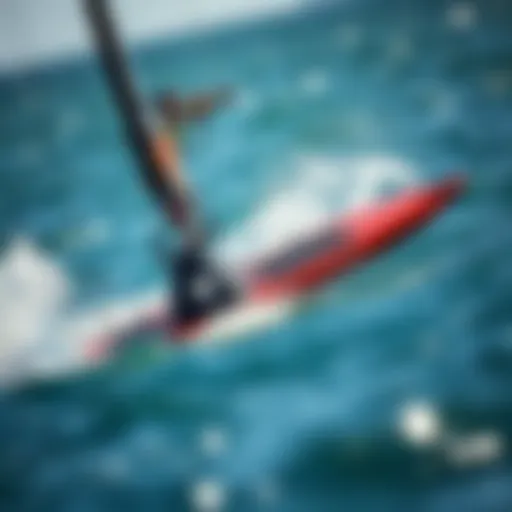Choosing the Ideal Trainer Kite: Key Considerations


Intro
Selecting the right trainer kite can substantially shape the beginning of your kiteboarding journey. With a variety of options swirling in the market, making a choice can become a daunting task if you’re not well-informed. Whether you are just stepping into kiteboarding or you are looking to refine your skills, understanding the essentials of trainer kites is crucial.
This section will dissect significant factors that impact your decision-making process. The overview will explore aspects such as design, performance, safety features, and budgetary considerations. Not all kites are made equal, and recognizing that nuance will equip you with the necessary knowledge to make an educated purchase.
Take a moment to consider the unique requirements of your kiteboarding adventure. It’s not merely about flying a kite; it’s about enhancing your experience on the water. Let’s take a closer look at the gear and equipment you’ll need.
Preamble to Trainer Kites
Trainer kites serve a special purpose in the kiteboarding community. They are designed primarily for beginners and those who aim to harness the craftsmanship of flying kites before diving into the world of kiteboarding. Learning to control a kite on land or water can provide you a strong foundation, making the transition to large kites much smoother.
While some may view trainer kites as mere toys, their importance cannot be understated. They are the stepping stones that cultivate essential skills while enhancing your understanding of wind dynamics, control, and safety. For newcomers to kiteboarding, these kites represent both an education tool and a preliminary investment that leads to a more enjoyable experience once you hit the water.
Definition and Purpose
Trainer kites are smaller, often more lightweight kites that are aimed at honing skills essential for kiteboarding. These kites usually possess a simpler design to encourage ease of use rather than sheer performance. Typically, a trainer kite consists of a bridle system, lightweight frame, and durable materials that withstand numerous practice sessions.
"A trainer kite offers an engaging way to build confidence and skill level before stepping up to the real deal of kiteboarding."
Their multi-faceted purpose also shines through: they can teach the user how to launch, land, and control a kite in various wind conditions. Besides fun, they're a safe practice platform where one learns about how different wind patterns influence kite behavior.
The Role of Trainer Kites in Learning Kiteboarding
Trainer kites act as a foundation upon which the rest of your kiteboarding journey is built. For newcomers, handling a larger kite without prior experience can be akin to steering a ship in a storm. Trainer kites offer a controlled environment where budding kiteboarders can establish essential skills like steering and power control without the added risk that comes with larger kites.
Here’s a short list of the benefits of using trainer kites in your learning process:
- Control Mastery: Develops your sense of control needed for kiteboarding.
- Wind Awareness: Enhances understanding of wind direction and strength.
- Safety Skills: Teaches how to safely launch and land kites.
- Boosts Confidence: Provides an opportunity to practice without overwhelming pressure.
In essence, trainer kites play an invaluable role in ensuring that learners feel prepared and equipped. They cultivate assurance and skill, serving as a vital bridge from curiosity to competence in the exhilarating world of kiteboarding.
Understanding Kite Design
The world of trainer kites can be as varied as the wind patterns they dance in. Understanding kite design is steeped in an appreciation of how different elements create unique experiences for users. It’s not just about aesthetics; kite design significantly influences performance, handling, and ultimately the fun factor that driving the kite gives. Functionality really stands tall in this conversation.
Types of Trainer Kites
When it comes to trainer kites, the primary two types generally are Foil Kites and Leading Edge Inflatable Kites. Each has unique attributes catering to different levels of skill and preferences.
Foil Kites
Foil kites are integral to kite design due to their simplicity and efficiency. A significant aspect of foil kites is that they don’t require a rigid frame. This characteristic makes them lightweight and compact, ideal for portability. The design consists of cells that inflate with air, which maintain the kite’s shape; this vented structure also allows for great pressure distribution, leading to impressive lift and stability, especially for emerging kiteboarders.
A key feature of foil kites is the wide wind range they offer. This versatility is a game changer for beginners who might struggle with varying wind conditions. However, they may struggle in very strong winds, thus requiring a steady hand to finesse their handling.
Advantages of foil kites include:
- Light weight, which aids in transport and handling.
- Strong lift even at lower wind speeds.
Conversely, their disadvantages may include:
- Sensitivity to oversteering in powerful gusts.
- The potential for collapsing, requiring more diligence in handling.
Leading Edge Inflatable Kites
Leading Edge Inflatable kites, or LEIs as they’re commonly called, present a different approach. These kites are built with inflatable bladders along the leading edge, thus ensuring they retain their shape and rigidity in any condition. This unique feature allows LEIs to be more forgiving in gusty winds, making them a popular choice among both novice and seasoned kiteboarders.


A hallmark characteristic of LEIs is their safety and stability, providing a smoother ride that instills confidence in users. Many kitesurfers gravitate toward them for the ease of relaunch; even if a kite takes a tumble, getting it back up is typically straightforward.
Benefits of Leading Edge Inflatable kites include:
- Excellent stability and lift in diverse wind conditions.
- Easier relaunch capabilities from the water.
However, they aren’t without drawbacks:
- Heavier than foil kites, affecting transport and handling.
- Require more maintenance to keep the bladders intact and functioning.
Effects of Kite Shape on Performance
The shape of a kite plays a pivotal role in its maneuverability and responsiveness. Various designs — from rounded tips to pointed edges — can create a spectrum of performance experiences. In essence, the holistic understanding of how these shapes impact riding dynamics is critical for selecting a trainer kite. Each modification in design doesn't go unnoticed; it directly affects how the kite behaves in the air and how the experience feels for the rider.
By comprehending these design details, kiteboarders can make an informed selection, ensuring that their kite aligns well with their journey — whether it's learning the ropes or perfecting complex tricks out on the water.
Above all, recognizing these nuances can greatly contribute to a kiteboarding experience that is more than just enjoyable but also reassuring and rewarding.
Performance Metrics for Trainer Kites
When it comes to selecting a trainer kite, understanding performance metrics is paramount. This knowledge not only informs your choices but enhances your overall kiteboarding experience. Performance metrics encompass various elements such as wind range, responsiveness, and stability, which are crucial for learners and experienced flyers alike.
The right performance metrics can make the difference between a frustrating session and a joyful one. If you choose a kite that is out of sync with your skill level or the current wind conditions, you’re likely to run into trouble. Thus, knowing how to assess these metrics sets you up for success on the wind.
Wind Range Considerations
Wind range is one of the first things you should examine when evaluating trainer kites. Essentially, this refers to the range of wind conditions your kite can effectively fly in. Each kite has a specified wind range indicated by the manufacturer, typically represented in knots (a measure of wind speed).
Here are some key aspects to help you understand wind range better:
- Minimum and Maximum Wind Speeds: A kite needs a certain amount of wind to lift off the ground, just as too much wind can make it difficult to control. Most trainer kites will specify a lower and upper wind speed limit. Too low, and you’re flapping in no breeze; too high might send you tumbling.
- Skill Level Alignment: If you’re just getting started, you might want a kite designed to work in lighter wind conditions. Novices may find high winds overwhelming and could struggle to control a fast, responsive kite.
- Location Conditions: If you frequent a specific locale, familiarize yourself with its average wind conditions. Wind patterns can greatly influence your choice. For example, if you tend to kite at a beach with unpredictable gusts, opting for a kite with an adaptable wind range can make your sessions safer and more enjoyable.
For kiteboarders dreaming of smooth sailing, being aware of wind range is not just advisable, it's essential.
Responsiveness and Stability
Another critical aspect to consider when selecting a trainer kite is its responsiveness and stability. These two attributes often go hand in hand, influencing the kite's flying behavior and your ability to steer it according to your intent.
- Responsiveness refers to how quickly and accurately a kite reacts to pilot inputs. A highly responsive kite allows for sharper turns and swifter maneuvers, which is particularly appealing for those looking to progress quickly in their skills. However, a kite that is too responsive may not be ideal for beginners who need a more forgiving experience to learn the ropes.
- Stability ensures that the kite flies predictably in various wind conditions. This is particularly crucial for trainers as stability allows novice flyers to concentrate on mastering basic controls without the kite suddenly nosediving or flipping out of control.
Incompatibility in these areas can lead to less-than-ideal experiences on the water.
To balance these two metrics, consider:
- Kite Shape and Design: A wider and flatter design tends to offer more stability, while a more dynamic shape may give greater responsiveness.
- Adjustable Settings: Some trainer kites come with features that allow for adjustments to the lines or wing tips, letting you modify the kite's sensitivity according to your skill level and comfort.
Safety Features in Trainer Kites
When it comes to kiteboarding, safety is paramount. Trainer kites, specifically designed for beginners and enthusiasts looking to hone their skills, incorporate features that prioritize user safety. By understanding these safety features, you’ll not only feel more at ease on the water but also gain confidence when flying your kite. Many people overlook the importance of safety features, thinking they’re only for advanced setups, but let me assure you, they play a crucial role in preventing accidents and promoting a positive learning experience.
Safety Leashes and Release Mechanisms
One of the cornerstones of safety in trainer kites is the safety leash. This is the line that connects the kite to the user’s harness, acting as a lifeline in unexpected situations. If a kite goes rogue, which can happen even to seasoned instructors, the safety leash enables you to disconnect quickly from the kite, potentially averting dangerous incidents.
A good safety leash should be easy to operate, even under stress. Some models come equipped with a quick-release mechanism that allows for immediate disconnection. This feature can mean the difference between a minor scare and a serious injury. For instance, if you find yourself in a tangle, being able to release your kite in a jiffy can save you from a tough time, or worse.
Key Points to Consider:


- Look for leash systems that are intuitive. If it takes more than a moment to figure out, it might be too complex.
- Ensure it’s durable and capable of withstanding the tension of a flying kite.
- Check user reviews about how quickly and reliably the release system performs under strain.
Inflation and Deflation Safety Practices
Inflating and deflating your trainer kite might seem straightforward, but there are several safety practices that wee often overlook during this process. Proper inflation and deflation are critical to maintaining control and the overall lifespan of your kite.
First and foremost, always ensure that your kite is clear of obstacles or people while inflating. A least a few feet of space helps avoid accidents. During inflation, it’s best to face the leading edge into the wind to maximize lift and minimize any collateral damage from unexpected gusts. Getting an assistant to hold the kite can be incredibly helpful. They can stabilize the kite while you prepare, making for smoother sailing.
Deflation is just as crucial. Always make sure the kite is completely deflated before packing it away. A kite with some air can get damaged easier during transport. Proper storage also means it’ll be ready to go when you are.
Safety Practices to Keep in Mind:
- Always Check the Environment: Wind direction and strength can influence how your kite behaves during inflation and deflation.
- Avoid Packed Areas: The space between you and barriers or people should always be clear.
- Store it Right: Use a designated bag for your trainer kite, and make sure it is dry and dirt-free before storage. This small step can prevent damage over time.
By keeping safety features and practices in mind, kiteboarding can transform from an intimidating endeavor into an enjoyable learning experience.
Factors to Consider When Choosing a Trainer Kite
Selecting the right trainer kite is a vital step in your kiteboarding journey. In this particular part of the guide, we will cover the key factors that every kiteboarder should keep in mind. Understanding these factors ensures that you pick a kite that not only meets your needs but also enhances your overall learning experience.
Skill Level and Experience
Your skill level and experience in kiteboarding significantly influence your choice of trainer kite. For beginners, it’s important to start with a kite that is forgiving and user-friendly. A simpler kite typically has more predictable flight characteristics, which allows new learners to gain confidence.
For instance, an easy-to-handle foil kite might be perfect for someone just starting out. It has no rigid frame, making it light and easy to launch from the ground. On the other hand, if you're more experienced, you might opt for a model like the Cabrinha Switchblade, known for its quick responsiveness and performance under a variety of wind conditions.
Key Considerations for Skill Level:
- Beginner: Look for kites that provide stability and ease of control.
- Intermediate/Advanced: Consider kites with more performance features like increased speed and agility.
Understanding where you fit within this skill spectrum will guide your decision and prevent frustration later on.
Budget and Cost Analysis
When it comes to selecting a trainer kite, budget plays an essential role. The price of kites can vary dramatically based on brand, design, and features. Typically, you can find trainer kites within a range from $150 upwards. It’s critical to understand what you are getting for your bucks. Higher price tags do not always mean better kites; sometimes, you’re simply paying for branding.
Analyzing Your Budget:
- Establish a Realistic Range: Determine how much you’re willing to invest before you start shopping.
- Include Additional Costs: Don’t forget to account for necessary accessories like lines, harnesses, and safety gear.
"Quality does not always come with a high price. Sometimes, it’s about balancing cost with features and brand reliability."
Identify models that meet your budget but also ensure they offer value in performance and safety. Reading user reviews and seeking recommendations can provide insights into which kites are worth the expense.
In summary, taking your skill level and budget into account is pivotal for your kite selection process. By focusing on these elements, you can ensure that your first steps into the world of kiteboarding are both enjoyable and fruitful.
Best Trainer Kites on the Market
When it comes to selecting a trainer kite, knowing the best options available on the market is crucial for both beginners and experienced kiteboarders. This section dives into the significance of understanding which kites stand out in terms of performance, user feedback, and overall value. The right trainer kite can not only accelerate your learning but also ensure safety and enjoyment during your kiteboarding journey. It's essential to evaluate the benefits and limitations of these kites as they cater to varying skill levels and preferences.
Overview of Top Recommendations
Brand A Model Review
The SkyHigh 1.5m Trainer Kite has gained quite a reputation among newcomers to the kiteboarding scene. Its lightweight construction makes it exceptionally easy to control, allowing inexperienced users to familiarize themselves with the nuances of kite flying. The notable aspect of the SkyHigh model is its reliable stability.
One of its most compelling features is its innovative bridle setup, which minimizes the potential for stalling during high winds. As a result, beginners will feel more secure honing their skills without the fear of unpredictable crashes. Many users appreciate this kite for its forgiving nature, which reduces the steep learning curve commonly associated with kiteboarding. However, its reduced size may hinder advanced tricks and higher-speed maneuvers, making it primarily a choice for learning and practice.


Brand B Model Review
On the other hand, we have the WindRider 2.0m Trainer Kite. What makes this kite a standout option is its robust design, equipped with a reinforced canopy that not only enhances durability but also contributes to a more responsive flying experience. It’s tailored for those who have a basic understanding of kiting and are looking to expand their skills.
Particularly appealing about the WindRider is its exceptional performance in moderate winds. Users can benefit from quick turns and well-defined control, attributes that make refining skills a bit more exciting. The downside of this model, however, is its protruding edges, which can snag on the ground when launching and landing, if not handled carefully. This feature could potentially deter first-timers who might prefer a kite with a more streamlined entry-level design.
User Feedback and Ratings
Exploring user reviews and ratings provides deeper insight into the performance and reliability of various trainer kites. Both the SkyHigh and WindRider models receive favorable feedback, with users often emphasizing the ease of handling and effective learning curves they offer.
For instance, customers on Reddit mention how the SkyHigh kite helped them progress in their skills within just a few sessions, boosting their confidence exponentially. Meanwhile, the WindRider has been praised for its sturdiness; users note that even after several intense sessions, the kite remains in good shape.
"The WindRider has been a game changer for me. I was worried I’d feel lost, but it's so responsive and fun to fly!"
User ratings from Facebook groups also shed light on the needs of different skill levels, illustrating how these kites adapt to the specific preferences of their pilots. It's clear that feedback from diverse experiences plays a significant role in making an informed selection.
In summary, analyzing the best trainer kites on the market not only highlights valuable features and user experiences but also assists in aligning personal expectations and training goals. Whether you lean towards the user-friendly SkyHigh or the performance-driven WindRider, understanding these models' nuances will enhance your kiteboarding journey.
Comparison of Trainer Kites
Selecting the right trainer kite doesn’t just hinge on personal opinion or aesthetics; it’s an intricate dance of various elements that can deeply impact your kiteboarding learning curve and enjoyment. Engaging in a comparison of trainer kites allows enthusiasts and novices alike to understand the strengths and weaknesses of different models, leading to more informed buying decisions. With a plethora of kites on the market, this comparison facilitates a deeper insight into the performance, price, and unique features of each kite, which is essential because it ensures you’re not only getting a kite that looks the part but one that performs excellently under the conditions you plan to ride.
Side-by-Side Analysis of Features
Performance Comparison
When it comes to performance comparison, a few key metrics come into play, such as responsiveness and stability across different wind conditions. Performance metrics will help you gauge how a trainer kite will behave in diverse settings, and understanding these is paramount in making a solid choice. High-quality kites, like those from brands such as Ozone or Cabrinha, often excel in maintaining stability, offering smooth handling, and ensuring efficient power delivery. This not only enhances the learning process but makes the ride more enjoyable.
One unique feature to focus on in terms of performance is the bridle system. Many kites utilize a two-line or four-line system.
- Two-line systems are easier to handle for beginners and allow for quicker reactions.
- Four-line kites, on the other hand, provide more control and responsiveness, beneficial as a learner grows in skill. While a two-line kite might be simpler, a four-line system provides progressive learning experiences. However, it can initially be a bit overwhelming, which is worth considering.
In sum, the performance comparison helps new kiteboarders understand what to expect as they take to the water, shaping their learning with each session.
Price Comparison
Price is often a deciding factor when selecting a trainer kite, and engaging in a price comparison allows consumers to weigh their options sensibly against their budget constraints. The cost of a trainer kite varies widely based on brand prestige, materials used, and included features, meaning that some well-known brands can command a premium price. Nevertheless, it is always possible to find mid-range options that perform admirably without breaking the bank.
An important characteristic of price comparison is understanding that more expensive doesn’t always mean better. Some entry-level kites from brands like Flysurfer or Best Kiteboarding provide excellent value. They perform reliably and have built-in safety features without the extravagant price tag.
Additionally, be cautious about enticing discounts or too-good-to-be-true deals that might compromise quality. Sometimes, less established brands can offer better prices but come with drawbacks like lack of customer support or product durability. Therefore, a thorough price comparison becomes a critical exercise that should be approached with both an open mind and a discerning eye.
Visual Performance Charts
In this day and age, data visualization is crucial for comprehending intricate comparisons swiftly. Visual performance charts can dramatically aid in understanding the performance and price differences across various trainer kites. Such charts might display metrics like stability ratings, wind ranges, and user satisfaction levels in an organized manner,
- They help to visually articulate which kites suit which conditions best.
- Further, they can be beneficial for visual learners who grasp concepts quicker when data is presented graphically.
Utilizing these charts alongside the other factors discussed deepens the understanding of what model might suit an individual’s specific needs, painting a clearer picture of what the very best trainer kite could be for a budding kiteboarder.
Culmination and Recommendations
As we draw the curtain on the exploration of trainer kites, it’s crucial to recognize the significance of making an informed choice. This article has embarked on an extensive journey through a myriad of factors that impact the selection of the right trainer kite, making it a vital read for anyone looking to delve into the world of kiteboarding. The recommendations that follow serve not just as tips but as guiding principles to help you navigate through this vibrant landscape of options.
Final Thoughts on Selecting the Right Kite
When it comes down to it, choosing the right trainer kite is akin to picking the right tool for a job. It involves a nuanced understanding of your own skill level alongside the kite’s capabilities. Remember, a kite can be a great companion, or it might be a troublesome anchor if mismatched. Consider this: If you’re a beginner, a kite that offers stability and ease of control is paramount. On the flip side, more seasoned kiteboarders might lean towards options that provide better responsiveness and performance nuances.
Additionally, thinking about your local wind conditions is vital. Each location offers its own set of variables. So, if you find yourself on a gusty beach one day and a gentle swell the next, having a kite suited to handle both could make all the difference in your learning curve and enjoyment.
Maintaining and Upgrading Your Trainer Kite
Once you’ve selected your perfect kite, maintenance becomes your next priority. Keeping your gear in peak condition can extend its lifespan significantly. Start with simple actions like rinsing the kite with fresh water after each session to prevent salt buildup. After all, the ocean might be your playground, but saltwater is not your kite's best friend.
Upgrading your gear is also something to consider as you grow in skill. You might not need a new kite right away, but sometimes swapping out lines or adding a new safety leash could enhance your kit without breaking the bank. Listen to what other kiteboarders say and gauge their experiences. Joining local forums on platforms like reddit.com or Facebook groups can provide not just information but also camaraderie.















